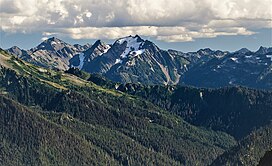Mount Delabarre
| Mount Delabarre | |
|---|---|
 Ice-clad Delabarre, north aspect | |
| Highest point | |
| Elevation | 6,024 ft (1,836 m)[1] |
| Prominence | 1,140 ft (350 m)[1] |
| Parent peak | Mount Christie (6,181 ft)[2] |
| Isolation | 2.56 mi (4.12 km)[2] |
| Coordinates | 47°41′11″N 123°29′36″W / 47.68625°N 123.49339°W[1] |
| Naming | |
| Etymology | W. R. Delabarre |
| Geography | |
| Country | United States |
| State | class 3 scrambling[1] |
Mount Delabarre is a remote 6,024-foot (1,836-metre) mountain summit deep within
History
The mountain is named after W. R. Delabarre, the Port Angeles banker who provided financial assistance for The Mountaineers' 1907 exploration into the Olympic Mountains, which included the first ascent of Mount Olympus.[4] At a later time, Delabarre and Asahel Curtis scouted a different trail to Mt. Olympus, and in the course of their journey, the men crossed the stream that would later officially bear his name.[5][6]
The mountain is also called "Mount Taylor",[1] but neither name has been officially adopted by the United States Board on Geographic Names, so the peak is not labelled on USGS maps.
Two scramble routes to the summit have been established: via Martins Park trail, and via Godkin-Rustler Pass.[1]
Climate
Based on the
Geology
The Olympic Mountains are composed of obducted clastic wedge material and oceanic crust, primarily Eocene sandstone, turbidite, and basaltic oceanic crust.[9] The mountains were sculpted during the Pleistocene era by erosion and glaciers advancing and retreating multiple times.
See also
References
- ^ a b c d e f g h Mount Delabarre, climbersguideolympics.com
- ^ a b "Delabarre, Mount – 6,024' WA". listsofjohn.com. Retrieved January 11, 2022.
- ^ "Mount Delabarre, Washington". Peakbagger.com.
- ISBN 9780898862065, page 206.
- ^ Parratt, Smitty (1984). Gods and Goblins: A Field Guide to Place Names of Olympic National Park (1st ed.).
- ^ "Delabarre Creek". Geographic Names Information System. United States Geological Survey, United States Department of the Interior. Retrieved January 11, 2022.
- ISSN 1027-5606.
- ^ a b McNulty, Tim (2009). Olympic National Park: A Natural History. Seattle, Washington: University of Washington Press.
- ISBN 0-87842-160-2.
External links
- "Olympic National Park". National Park Service. Archived from the original on January 4, 2022.
- Weather forecast
- Aerial photo: PBase
- Aerial photo: Flickr


